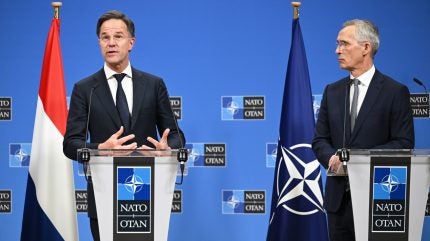
Dutch Prime Minister Mark Rutte was yesterday (20 June) all but confirmed as Nato’s next Secretary General after the only other candidate, Romanian President Klaus Iohannis, told the military alliance he would withdraw his bid.
Rutte, a staunch Ukraine supporter who has received praise for dealing with former US President Donald Trump, gained the candidacy endorsement of key players including Germany, France, the UK and the US.
Hungary, Turkey and Romania initially expressed reservations but are now reportedly on board with Rutte replacing the incumbent Jens Stoltenberg when his term finishes in October.
The news came days after Stoltenberg announced that a record number of Nato members – 23 of the total 32 nations – will this year meet the alliance’s key goal of spending 2% of GDP on defence.
This includes Nato’s two newest members, Sweden and Finland. The accessions of the two Nordic countries were prompted by fears of Russian invasion – a shadow that also looms large over the Russia-neighbouring Baltics.
The Baltic states have been the most vocal proponents of raising Nato’s defence spending target to 2.5%.
Alongside Poland and the US, Lithuania, Latvia and Estonia usually rank high in Nato’s GDP spending charts – as does the UK, where the current Conservative government and the likely incoming Labour Party have both pledged to raise spending to 2.5% of GDP.
Transatlantic troubles
However, Rutte’s reasonable record of Trump diplomacy is unlikely to placate Nato members’ fears of the US decreasing its support for the alliance should Trump gain office in the White House come November.
Trump stoked these fears in February, saying he would “encourage” Putin to attack any Nato member that does not meet defence spending benchmarks. President Biden described Trump’s remarks as “appalling and unhinged”.
Some have questioned how many geopolitical fronts the US can maintain as Washington looks to keep backing South Korea, Taiwan and the Philippines against rising Chinese aggression in the Indo-Peninsula while supporting Israel’s offensives into Gaza and Lebanon.
All these topics will be discussed at the upcoming Nato summit in Washington next month – as will military aid for Ukraine.
Unprecedented Nato integration
Despite potential transatlantic tensions, most indicators point to tighter Nato bonds than ever before.
The rising trend of pooling and sharing forces allows Nato countries to quickly tackle security threats that cannot be fully addressed by one country, according to GlobalData’s European Defence Integration – Thematic Intelligence report.
Examples include Operation Atalanta, a counter-piracy maritime force tasked with combatting Somalian piracy in the Horn of Africa, as well as the EU-led Operation Poseidon in Greece and Operation Triton in Italy and Malta, established to improve border surveillance and search and rescue (SAR) due to the refugee crisis.
Nato and the EU also coordinate over the Sky Shield system, a common network of anti-missile defences.
Stoltenberg, Rutte and other key Nato figures will hope the rollout of these projects continues steadily, as the alliance navigates the strategic risks and elections of the next six months.



